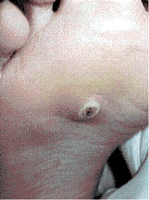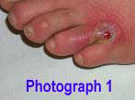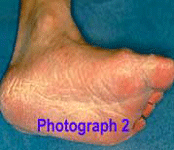“Health Matters”
Below are some important to pics on heath subjects that can affect martial artists in the dojo.
pics on heath subjects that can affect martial artists in the dojo.
Verrucae
General Information

Verrucae (plural of verruca) are caused by the human papilloma virus and may occur as single or multiple growths affecting the hands and feet. Verrucae are one of the most common viral infections of the skin. They are caught by cross-infection from communal floor areas such as swimming pools, communal showers and dojo floors. Cuts or blisters on the foot will increase the chances of infection, because these provide an easier entry point for the virus. Those most at risk are people who have very sweaty feet, as the wetter and therefore softer skin can be more easily penetrated by the virus, however, there is no known reason as to why some people are, or become, more susceptible than others. The virus has a lengthy incubation period, which means that it may lay undetected, within the tissues of the skin, for up to a year before appearing on the surface of the skin as a verruca. The virus is extremely contagious, both to the person with the verruca and to others. Verrucae can only be spread by contact with the virus itself and the virus cannot spread “through” the body via the blood vessels etc.
Treatment
Some verrucae will disappear spontaneously, without any treatment, however, it is impossible to know whether any particular verruca will disappear or indeed multiply. However, treatment is usually recommended if, especially if you are training in the dojo. This is to prevent an outbreak amongst all the students. They can also:
- be painful
- spread rapidly and you can have more than one verruca present
- be present for 2 years or longer
- spread to other members of the family
It is best to treat them as early as possible, therefore after identification treatment with one of the following methods is advisable:
- Go to a chiropodist fro treatment
- Purchase ointments or liquids from a pharmacist. One of the best is “Wattner”, a freeze spray. It has been known in my opinion using the cream “Bazuka” does not work very well and they can come back. However, other have said that it has worked.
- If in doubt see your doctor.
Please note that “over the counter” Wart/Verruca treatments Must be used carefully or NOT AT ALL!
Students must, once the Verruca has been identified, cover them up in tape bound around the foot. Do Not Use a verruca sock as this is dangerous when training in martial arts.
Do Not train without them covered as this just spreads them amongst other students.
From the same viral family – Warts
Warts are small, skin-coloured, roughish lumps on the skin. They often appear on the hands and feet and look different depending on where they are on the body and how thick the skin is.
Warts are caused by an infection with a virus called human papilloma virus (HPV). There are many different types of this virus. It causes a reaction with the skin that makes part of the top layer of skin (the epidermis) grow too much. Keratin is the hard protein in the skin that grows too much, causing the rough, hard texture of warts.
Warts are usually harmless, but they can look unsightly. They often clear up by themselves, but treatment can help to get rid of them more quickly. Warts aren’t normally painful, although Verrucae (warts on the feet) can sometimes hurt.
Warts are very contagious (easy to spread and catch). The skin cells in the warts releases thousands of viruses, so close skin-to-skin contact can pass on the infection. However, it can take several months for warts and Verrucae to appear after you’ve caught the infection.
People with weak immune systems (the part of the body that fights infection), are more likely to get warts. This is because the body is less able to fight off the HPV virus.
Most people develop warts at some point in their life, usually before the age of 20. About 1 in 10 people in the UK have warts at any one time.
ATHLETES FOOT
What is athlete’s foot?
Athlete’s foot (tinea pedis) is a fungal infection of the feet. It is recognisable by a red, itchy rash, which usually starts between the fourth and fifth toe. This can become sore, cracked and scaly or moist, white and peeling.
What causes it?
The fungi that cause athlete’s foot live on the body and are usually harmless, however, certain conditions cause them to get out of hand. These include:
- Hot, damp, sweaty trainers, which is why athlete’s foot is so common in young men and, of course, athletes.
- Warm, moist feet which haven’t been dried properly.
- You can also pick athlete’s foot up from someone else as it is can be spread by direct skin-to-skin contact and indirect contact, e.g., picking it up from swimming pool and changing room floors.
|
|
|
How to avoid it?
A good hygiene routine can help you to avoid athlete’s foot:
- Wash your feet daily
- Dry your feet thoroughly, especially between the toes
- Try to wear different shoes every day, as it can take 24 hours for sweaty shoe linings to dry out
- Always wear clean socks or hosiery every day
- Go barefooted or wear open-toed sandals or flip-flops whenever the weather allows
- If you are prone to sweaty feet, avoid socks and shoes made from synthetic materials – go for cotton, wool and leather
Diagnosis and treatments
It’s usually possible to tell that you have athlete’s foot through the appearance of your feet. If so, it’s important that you treat it as soon as possible as it can progress to the toenails, which can result in having your nails removed. Treatments don’t usually require a prescription and include:
- Anti-fungal creams, sprays or liquids that can be applied directly to the infected area, usually two or three times a day.
- Anti-fungal powders that should be shaken into your footwear, as well as applied to the foot.
The infection should clear up within two weeks. If it doesn’t, see your GP as you may need a more powerful anti-fungal treatment. If it does clear up in two weeks, continue using your anti-fungal treatment for a while longer to ensure that the infection has gone.


